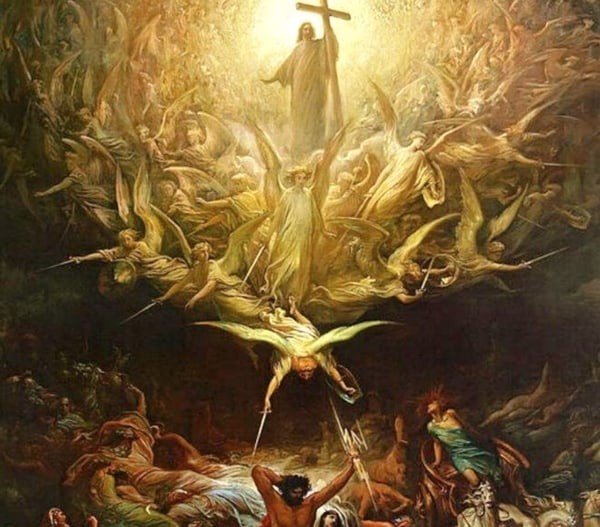
In my last post I surveyed some Biblical examples of failed apocalyptic predictions of imminent judgment in the end times. In today’s post, I turn to some further examples from throughout church history. In my next post I will look at a few examples in other religions.
Montanist Millenarians
Many believers in Christianity’s first few centuries held imminent apocalyptic beliefs. One well known group was the Montanists.
Montanus and two charismatic female prophets, Maximilla and Prisca, claimed to receive new revelation from God (“New Prophesy”). They claimed that a new age of the Spirit was dawning and that the New Jerusalem would soon descend near the town of Pepuza (Kirsch, 2006, pp. 104-105). This imminent end called for strict ascetic living and no compromise under Roman persecution.
According to Maximilla, “after me there will be no prophesy, but the End” (Kirsch, 2006, p. 104). Montanism impressed no less a theologian than Tertullian, who wrote of reports from Roman soldiers stationed in Palestine who claimed to “see the spires and towers of a city hovering above the horizon at dawn – surely an early sighting of the celestial Jerusalem!” (Kirsch, 2006, p. 105).
Of course, none of this came about. Montanism was eventually condemned as heretical and mostly died out by the 6th century CE.
Apocalypticism and the Crusades
While Christianity has always sparked imminent apocalyptic movements, from Augustine till well into the middle ages much of this was subdued. The anticipated final end had not materialized. Christianity had gone from persecuted sect to the official religion of the empire. Finally, an allegorical and amillenial approach to prophesy came to predominate, with the millennial kingdom being seen as corresponding to the church age (Kyle, 1998, pp. 37-39).
But there were notable exceptions. Imminent apocalyptic expectations played into the violence of the Crusades. Timothy Weber explains:
Many believed that the rise and spread of Islam, the Viking and Magyar invasions, and the Muslim capture of Jerusalem meant that the end was near…In a version of his 1095 sermon that led to the First Crusade, Pope Urban II stated that an expedition to free Jerusalem would help the faith “flourish again in these last times, so that when Antichrist begins his reign there – as he shortly must – he will find enough Christians to fight.” Peasants by the thousands joined the People’s Crusade, hoping to be in the holy land when Jesus established his kingdom. They also believed it was their duty to kill Jews along the way. Their justification: the Antichrist will come from the tribe of Dan, and Jews will be among his most devoted followers (Weber in Walls, 2008, p. 371).
Jonathan Kirsch notes the apocalyptic fervor that accompanied the Crusades, including vivid religious experiences:
“Many portents appeared in the sky as well as on the earth, and excited not a few who were previously indifferent to the Crusades,” writes Ekkehard of Aura in Jerusalem Journey, an account from the eleventh century. “Some showed the sign of the cross stamped by divine influence on their foreheads or clothes or on some parts of their body, and by that mark they believed themselves to be ordained for the army of God” (Kirsch, 2006, pp. 163-164).
English Puritan Apocalypticism
The Reformation would lead to another upswell in imminent apocalyptic expectations. Perhaps the most infamous incident is the disastrous theocracy that was attempted at Munster. However, I will use a few examples from the English and American Puritans.
Apocalyptic expectations exploded in England in the 16th and 17th centuries, peaking in the late 1640s and 1650s (Kyle, 1998, pp. 64-66). Many social and religious factors played into this phenomenon. Richard Kyle explains the outlook:
The Reformation paved the way for Christ’s return by exposing the papal Antichrist. The defeat of the Spanish Armada in 1588 convinced many that England was God’s instrument – the elect nation. The advance of the Turks into Europe horrified many English, persuading them that the hordes of Gog and Magog were at their doorsteps…most contemporary English people saw the Thirty Years War as a religious conflict (Kyle, 1998, p. 66),
After England’s break with Roman Catholicism under King Henry VIII, fierce conflict ensued over what form the Church of England should take. The Puritans saw the Church of England as still too Catholic and they associated both it and the Papacy with the Antichrist. The persecution of the Puritans and their defiant opposition would eventually lead to the English Civil War.
In that war, both the Puritans and their opponents saw each other as in league with the Antichrist (Kirsch, 1998, p. 175). “The Puritans understood their quarrel with the king in prophetic terms: they were God’s army fighting against the army of the papal Antichrist and his ally, the English king” (Weber in Walls, 2008, p. 374) .
After the Puritan army under Oliver Cromwell defeated the royalists and captured and executed King Charles I, there was intense debate over what kind of government was needed until Jesus’ second coming, widely expected by 1736 (Weber in Walls, 2008, p. 375).
One group that almost gained control were the Fifth Monarchists. They took their name from Daniel 7, which described the world’s four great empires. Supposedly, the fall of the fourth empire’s final king would inaugurate the government of God and his saints (Weber in Walls, 2008, p. 375). Kyle surveys some of their basic beliefs:
The reign of God on earth would of course begin in England…The Antichrist was to be destroyed, England purified, and then the kingdom of Christ would spread throughout the world. The English armies led by Oliver Cromwell would sweep through Europe and defeat the pope. The Jews meanwhile would return to the Holy Land and defeat the Turks. These events would come to pass between 1655 and 1657 (Kyle, 1998, p. 67).
Cromwell ended up rejecting the Fifth Monarchists’ demands as too extreme. They revolted and were defeated. Kirsch narrates how, as soldiers broke into one of their rallies, they cried “Lord, appear, now or never.” “Needless to say, the Lord was once again a no-show” (Kirsch, 2006, p. 176).
Eventually Cromwell himself died and the throne returned again to Charles II, the beheaded king’s son.
The year 1666 and the connection between 1000 years (the millennium) and 666 (the number of the beast) led many to believe that 1666 would be the time of the end. “The Quaker George Fox wrote that in 1666 nearly every thunderstorm aroused end-time anxiety” (Kyle, 1998, pp. 67-68).
New England Puritan Apocalypticism
Imminent apocalyptic beliefs thoroughly colored the American Puritans and has colored much of American religion since then. As Kyle notes, “Americans have tended to see themselves as the chosen nation and their enemies as demonic” (Kyle, 1998, p. 78).
I note in passing that eschatological beliefs played a significant role in colonialism more generally. For example, Columbus wrote an apocalyptic Book of Prophesies and was partly motivated in his colonial endeavors by the desire to finance the reconquest of Jerusalem from the Muslims and convert the heathen in the East to help bring in the final end (Kyle, 1998, p. 57).
The Puritans saw America as a New Jerusalem, a City upon a Hill, and themselves as a kind of new Israel. For example, John Cotton preached that New England was “the new promised land reserved by God for his elect people as the actual site for a new heaven and a new earth” (quoted in Kirsch, 2006, p. 173).
These convictions played into the way they saw and treated Native Americans. For example, Increase Mather suggested that the red horse of the Apocalypse foretold the bloodshed between the colonialists and Native Americans in King Philip’s War. His son Cotton Mather regarded Native American opponents as in league with the Antichrist (Kyle, 1998, pp. 78-79). Not unrelatedly, some Puritans justified genocidal murder of Native Americans by appeal to Old Testament passages commanding the Israelites to exterminate the Canaanites (Boyd, 2017, pp. 26- 27).
Imminent apocalyptic expectations also played into the hysteria of the Salem Witch trials. Speaking of Cotton Mather, the above mentioned Puritan minister, who also played an integral role in the trials, historian Damian Thompson explains: “Fear of witches is above all evidence of End-time anxiety, since it was believed that the Last Days would see a terrible loosing of the powers of darkness” (quoted in Kirsch, 2006, p. 178). Mather also dabbled in date-setting, predicting that the end would arrive first in 1697 and then 1716 (Kyle, 1998, p. 79). Needless to say, this did not happen.
The Millerite “Great Disappointment”
Moving to another example, one of the most famous failed apocalyptic predictions in American history was the Millerite “Great Disappointment” of 1844. American Baptist layman William Miller came to believe that the 2,300 days predicted in Daniel 8:14 actually corresponded to 2,300 years and that the sanctuary cleansing the text predicted referred to Jesus’ second coming. Through an elaborate analysis, Miller’s calculations indicated to him that Jesus would return in 1843 (Kyle, 1998, p. 89).
The cautious Miller at first continued his studies and kept his ideas to himself. But he and others later started to share them widely in huge evangelistic tours that converted many. According to Kyle, at its high point, there may have been anywhere between thirty to one hundred thousand Millerites (Kyle, 1998, p. 89).
When Christ did not return in Miller’s 1843 timetable, he recalculated and came up with even more specifics dates: first March 21, 1844 and then October 6, 1844. Kyle describes what subsequently happened:
From about mid-August to October the Millerites engaged in a frenzy of activity. They flooded the country with their periodicals, books, and pamphlets. Many withdrew from their churches in anticipation of the second advent. They were instructed to get their affairs in order. Many did – selling their property, closing their stores, resigning their jobs, and abandoning their animals and crops…But the Great Disappointment was the last straw. When the Lord dis not return as expected, massive confusion and disillusionment set in…The Millerite movement fragmented and went in several directions (Kyle, 1998, pp. 90-91).
Dispensational Premillennial Predictions
As my last example from church history, I will look at still enormously influential dispensational premillennial teachings on the end times. I will spend a little more time on this view because it exercises enormous influence over American Christianity and politics. I will also highlight other problems with it in a later post.
Dispensationalism is a conservative Evangelical view that arose in the mid-19th century. It claims that God relates to people throughout history in different ways depending on which “dispensation” they live in. Classic Dispensationalism teaches that God has two eternally district peoples: Israel and the church.
Dispensational premillennialism teaches that God will restore the Jewish people to the land of Israel and that there will be a “rapture” of believers before and distinct from Jesus’ “second coming.” Dispensationalists believe that earth has a predetermined pessimistic future, with a single Antichrist figure who will gain world power, a seven year tribulation period, and a variety of severe supernatural judgments that will occur before Jesus’ second coming, the battle of Armageddon, the enactment of a one thousand year millennial kingdom, and after that a final resurrection and judgment.
There are a number of problems with dispensationalism. Most of them fall outside the scope of this series, but I note in passing that their beliefs about ethnic Jews being uniquely and eternally favored by God face serious evidential, moral, and theological problems. Such views are contradicted by the way the New Testament interprets the Old Testament and understands God’s one people. Their framework for interpreting the Bible is only selectively literal and involves implausible exegetical leaps. Finally, even if Jewish people were eternally chosen by God, they would be held to certain conditions under the Mosaic covenant, such as treating other inhabitants of the land with justice, which the modern state of Israel is violating.
In a future post I will note a number of serious moral and pragmatic problems that flow out of dispensationalism’s view of Israel and its fatalistic view of the end times. However, in today’s post I use it as an example of failed imminent apocalyptic expectations.
As Kyle observes, part of the genius of dispensationalism is that,
It does not lock itself into a specific schedule for the second advent. On one hand, it avoids setting exact dates for Christ’s return (though some dispensationalists have fallen into this trap). On the other, it maintains an intense expectancy for the secret rapture. Christ could return at any time. Yet he may delay his return for years. While the historic premillennialists were wedded to exact millennial arithmetic, the dispensationalists lived with “maybes,” (Kyle, 1998, p. 103).
With Kyle’s characterization in mind, I will obviously not be able to show that dispensationalism is definitively falsified by failed expectations. My more modest goal here is three-fold. I want to:
1) Show how a common dispensational interpretation of modern Israel as the fig tree in Matthew 24:32-34, supposedly signaling that Jesus will come again within a generation, is becoming ever more implausible. 2) Give some examples of prominent dispensationalists who have fallen into the date-setting trap and been shown to be wrong. And 3) point out how often dispensationalists have had to scramble their ideas about the end times cast.
First of all, we begin with a common dispensational interpretation of Matthew 24:32-34. This passage reads as follows:
“Now learn this lesson from the fig tree: As soon as its twigs get tender and its leaves come out, you know that summer is near. Even so, when you see all these things, you know that it is near, right at the door. Truly I tell you, this generation will certainly not pass away until all these things have happened.”
In its original context, this passage probably referred to the generation of Jesus’ contemporaries (as I argued in a previous post). However, to get out of the implication that Jesus was wrong, some dispensationalists have argued that “this generation” actually refers to a future generation that will go through the events of the end.
The turbulent changes of the twentieth century and especially the emergence of the modern state of Israel played into dispensationalists anxieties and enthusiasm. They saw the re-emergence of Israel as a miraculous fulfillment of prophesy; though it is easily explicable as a normal historical event (see Bunton, 2013). This supposed fulfillment has played into the plausibility of dispensationalism to many (Kyle, 1998, p. 116).
According to Harold Lindsey and some other prominent dispensationalists, the fig tree that puts forth its first leaves (signally that the return of Christ is near) was the emergence of the modern nation of Israel.
Lindsey equates the fig tree with Israel: “When the Jewish people, after nearly 2000 years of exile…became a nation on May 14, 1948, the ‘fig tree’ put forth its first leaves.”…Lindsey contends that Jesus is here connecting his second coming with the rebirth of Israel. Noting that a biblical generation was about forty years, he goes on to say that “within forty years or so of 1948, all these things will take place” (Kyle, 1998, p. 119).
Later on, as it became clear that his prediction was not going to happen, Lindsey backtracked. He reminding his readers that he had qualified his earlier prediction and suggested that Matthew 24:34 might instead have the events of Israel’s 1967 Six Day War in mind. He also redefined a biblical generation as “somewhere between 40 and 100 years” (Kyle, 1998, p. 119).
But this too is becomes more-and-more implausible. The outer limit to these new predictions will be 2067. When Jesus does not return by then, I fully expect dispensationalists to change their narrative once again. Perhaps those who still hold to this interpretation of Matthew 24: 32-34 will abandon it for another. Perhaps they will say that the fig tree showing its leaves refers to some other event they expect related to Israel: the rebuilding of the temple, the expansion of Israel to its supposed “full biblical boundaries.” I expect for dispensationalists to push for these “fulfillments,” in spite of the violence and injustice they would necessitate.
Secondly, let me give some other examples of prominent dispensationalists who have made failed predictions of immanent apocalyptic judgment.
According to the Bible teacher and prophesy expert Leonard Sale-Harrison, Italian dictator Benito Mussolini was the predicted Antichrist and the end would come in 1940 or 1941 (Kyle, 1998, p. 111).
In his 1950 crusade, Billy Graham told his audience: “We may have another year, maybe two years to work for Jesus, and [then] ladies and gentlemen, I believe it is all going to be over” (Kirsch, 2006, pp. 218-219).
Chuck Smith, the long-time pastor of Calvary Chapel in Southern California, declared in one of his books (Future Survival) that, “the Lord is coming for his church before the end of 1981,” a mistake Smith later repented of (Kyle, 1998, p. 120).
Influential televangelist and end times expert, Jack Van Impe, insisted in a 1975 newsletter that the “Soviet flag would fly over Independence Hall in Philadelphia by 1976” (Kyle, 1998, p. 120). One of his videos from 1992 indicated that the rapture, World War III, and Armageddon would occur in about eight years (Kyle, 1998, p. 120).
I remember chuckling to myself at a book I saw at my Aunt Connie’s called 88 Reasons Why the Rapture Will Be in 1988, by Edgar Whisenant. According to Kyle the book sold 2 million copies (Kyle, 121). Presumably Whisenant’s rationales stemmed (like Lindsey’s)from his interpretation of current events and especially the perceived significance of the modern state of Israel.
In his book Armageddon: Appointment with Destiny, Grand R. Jeffries indicated that the end is near and will probably occur around the year 2000 (Kyle, 1998, p. 120).
Of course, many dispensationalists discourage such specific and sensationalist date-setting. But many of the more popular proponents gravitate toward this, or claims very close to it.
Beyond the date setting problem, popular dispensationalist are regularly having to revise their understandings of which individuals, countries, and events will likely be the fulfillers of God’s end times plan.
For example, note how the common interpretation of Gog and Magog as referring the Soviet Union had to be scrapped after its collapse in the early 1990s. Now it is common for dispensationalists to see Gog and Magog as referring to an Islamic confederacy (Kirsch, 2006, p. 225).
G. K. Beale observes,
Interpreters who hold this view [a futurist approach to Revelation] are constantly changing their interpretation of historical events to make what is happening currently fit into the pattern. In the twentieth century alone, for instance, numerous individuals, from Hitler to Saddam Hussein, with various popes and other politicians (as has been the case from the medieval period up to the present), have been identified as the antichrist, and then quietly discarded when they pass from the scene. The same is true with specific historical events or institutions (the Second World War, the European Common Market, the Gulf War, Y2K, Saddam Hussein’s supposed rebuilding of Babylon). In short, the Bible is interpreted by modern events first, instead of by itself (Beale, 2015, p. 8).
In my next post I will look at some examples of failed apocalyptic predictions of imminent judgment in other religions.
References
Beale, G. K. and Campbell, D. H. (2015). Revelation: A shorter commentary. Grand Rapids, MI: WM. B. Eerdmans Publishing Co.
Boyd, G. A., (2017). Crucifixion of the warrior god: Interpreting the old testament’s violent portraits of god in light of the cross, vol. 1. Minneapolis, MN: Fortress Press.
Bunton, M. (2013). The palestinian-israeli conflict: A very short introduction. Oxford, UK: Oxford University Press.
Kirsch, J. (2006). A history of the end of the world: How the most controversial book in the bible changed the course of western civilization. New York, NY: HarperSanFrancisco.
Kyle, R. (1998). The last days are here again: A history of the end times. Grand Rapids, MI: Baker Books.
Weber, T. P. “Millennialism” in The Oxford Handbook of Eschatology. Ed. Jerry L. Walls. New York, NY: Oxford University Press, 2008. pp. 365-383. Print.




